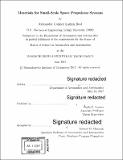Materials for small-scale space propulsion systems
Author(s)
Bost, Alexander Connor Larkin
DownloadFull printable version (13.07Mb)
Other Contributors
Massachusetts Institute of Technology. Department of Aeronautics and Astronautics.
Advisor
Paulo C. Lozano.
Terms of use
Metadata
Show full item recordAbstract
This thesis explores a variety of materials and methods for creating emitter arrays for the ion electrospray propulsion system (iEPS), a compact, efficient, and scalable space propulsion system for use in a wide range of space missions. The increasing utilization of small, cheap, easy-to-launch satellites known as CubeSats has spurred demand for a propulsion system which exists at the nexus of high power efficiency, low mass, surface area, and volume, and high specific impulse. iEPS has demonstrated a unique potential to satisfy all of these stringent design requirements in a way no presently existing propulsion system can. The first part of this work explores utilizing microelectromechanical systems (MEMS) processing to increase the thrust density of iEPS. Silicon molds were designed and manufactured with differing emission site size and spacing. Additionally, a variety of materials were tested with the aim of forming a porous network within the molds prior to selective removal of the mold. A molded array is successfully fired as a result of these research efforts. The second part of this work explores creation of porous substrates for use with an existing laser ablation method of creating emitter arrays. The first iEPS thrusters tested in space used porous borosilicate glass emitter chips, which demonstrated shortcomings in terms of material uniformity, pore size, and ionic liquid fuel containment. This work explores materials and methods for improving all of these and demonstrates the successful firing of an array made by sintering a silicon dioxide nano-bead powder.
Description
Thesis: S.M., Massachusetts Institute of Technology, Department of Aeronautics and Astronautics, 2017. Cataloged from PDF version of thesis. Includes bibliographical references (pages 91-92).
Date issued
2017Department
Massachusetts Institute of Technology. Department of Aeronautics and AstronauticsPublisher
Massachusetts Institute of Technology
Keywords
Aeronautics and Astronautics.